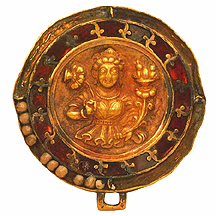
Kushan period, 4th century CE
Gold repoussé with garnet inlay and pearls
Taxila (?)
Diameter: 4.5 cm
Acquisition number: #I.S. 9-1948
Formerly Col. D.H. Gordon collection
Image courtesy of the Victoria and Albert Museum (copyright reserved).
This medallion displays a number of elements that reflect Mediterranean, Indian, and possibly even Sassanian influence. The figure portrayed here has been identified as Hariti due to the attributes, which include a lotus blossom in her right hand, and a cornucopia blossoming out of another lotus flower she carries in her left hand. From the cornucopia rises a flask surrounded by pomegranates, a fruit with which Hariti is associated. According to popular legend, Hariti was a fierce goddess who consumed the flesh of children. The Buddha offered her pomegranates, which resembled human flesh, as a substitute, and in this manner she was converted from a wrathful demons to a loving protector of children.1
The similarities between Hariti and the Greek goddess Tyche are striking. Both commonly carry cornucopia, and in examples of Tyche seen in sculpture in Charsada and Hadda, a similar diadem and tunic is depicted. For this reason, this particular iconographic Hariti type likely evolved from the Greek model of Tyche.2 In terms of non-representational design, the border of pearls and fleur-de-lys patterns indicate an importation of Sassanian design motifs, and also help establish a fourth century date.
Notes:
(1) The Crossroads of Asia: Transformation of Image and Symbol in the Art of Ancient Afghanistan and Pakistan (Cambridge: The Ancient India and Iran Trust, 1992), p. 143.
(2) Ibid.